Work Progress
1997/8
The first phase started during the winter of 1997/8 with a minor
change to the layout at the north end of the station. The point
leading from number one road to the up sidings was damaged a
while ago and, together with some of the pointwork in the
sidings, was just about the first work to be done on the
Permanent Way. The point leading to the Dock at the south end of
the station was moved from its position in number three road to
the north end of number one road where it forms the new entry to
the sidings on the up side of the line. The old, damaged, point
had been a facing point for up movements through the platform
road, but the newly installed one is a trailing point. For the
present this point is hand operated by a point lever and is only
used for shunting movements.
During 1998 much preparatory work was carried out. The obvious
signs were the new signal posts that sprouted north of the
station, as yet to be adorned with their "boards", and the big
new bracket to the south. What the casual observer did not see
was the vast amount of new cabling installed, ready for
connection to the signals, points and 'box.
1999
The more apparent work was started. The wires and rodding for
the signals and points were disconnected on 5th January, leaving
the signalbox with just the staff/token instruments and
telephones with which to control traffic. Safety, always the
number one priority, is being maintained thoughout the period of
the box's disconnection with all movements into, through and out
of the station area under the sole control of the duty signalman
who, when two trains or more are operating, has a hand-signalman
to assist him.
 Left: Signalman Chris Majer
exhibits a yellow flag to denote proceed with caution as
Stepney arrives at Horsted Keynes inner home signal
with the two Chesham coaches on Sunday, 14th February
1999.
Left: Signalman Chris Majer
exhibits a yellow flag to denote proceed with caution as
Stepney arrives at Horsted Keynes inner home signal
with the two Chesham coaches on Sunday, 14th February
1999.
Whilst work is in progress another, temporary, ground frame
has been installed at the south end of the station. This controls
the point dividing what are now called Nº2/3 and Nº4
roads (the old 19B), a lock for this point when entering Nº4
road and the platform starter south from Nº3 road.
During the last week of February the Permanent Way work began
in earnest, showing how the re-modelled south end trackwork would
appear. The old dock road, taken up two winters previously when
the point was moved to the north of the station, is being
re-instated but not branching off the running line as before but
off the down sidings.
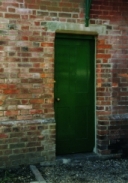 The keen observer
will see that there has been some work done to the north end of
the ground floor of the signalbox. The brickwork needed some
remedial work and, at the same time, the doorway has been moved
about 18 inches towards the rear of the box. This is because the
bottom of the levers in the re-installed frame when "normal" in
the frame would, by the doorway, be a dangerous hazard for anyone
venturing inside. The work has been excellently carried out by an
outside contractor and, once a little weathered, will show no
sign of the alteration having been made. The lintel over the
door, the stone step (moved exactly as it was, crack and all!)
and most of the original bricks were re-used. The cost of this
work, some £870 for labour (the materials were supplied by
the railway) was met from the proceeds of the Football
Competitions run to raise funds for the work now taking place on
the signalbox and signalling.
The keen observer
will see that there has been some work done to the north end of
the ground floor of the signalbox. The brickwork needed some
remedial work and, at the same time, the doorway has been moved
about 18 inches towards the rear of the box. This is because the
bottom of the levers in the re-installed frame when "normal" in
the frame would, by the doorway, be a dangerous hazard for anyone
venturing inside. The work has been excellently carried out by an
outside contractor and, once a little weathered, will show no
sign of the alteration having been made. The lintel over the
door, the stone step (moved exactly as it was, crack and all!)
and most of the original bricks were re-used. The cost of this
work, some £870 for labour (the materials were supplied by
the railway) was met from the proceeds of the Football
Competitions run to raise funds for the work now taking place on
the signalbox and signalling.
The end of May saw the re-instatement of the up outer home,
down home and the down advanced starter signals. These
re-instated signals are worked by panel switches in Horsted
signalbox but will, eventually, be worked from the lever frame
once again.
10th July saw two point machines installed, one on the points
(23A) south of platforms three and four, the turnout for the down
sidings, and one on the first points (25) inside the sidings.
These are not yet connected to the 'box but as they are operated
(by winding) in the same manner as if they were connected, and as
they incorporate a facing point lock, we were once again able to
dispatch trains south from what are now platforms four and five.
Until the points are connected to the 'box they will still need
to be kept clipped and padlocked.
The bracket for the new Inner Home signal was erected back in
1998. This fine structure is the work of the Alf Brown gang but
suffered during the time between erection and completion from the
effects of the smoke from passing engines and the weather
causing pivot pins to seize but these are now kept free simply by
dint of the signal being in regular use. The smoke damage was to
the electrical detection equipment and was more serious as it
cannot be avoided by simple use of the signal, so to endeavour to
prevent this happening again, a smoke shield has been fitted to
the underside of the bracket. The new Inner Home no longer
carries a Distant Arm as this has been re-located to the Outer
Home Signal. The signal has a new Route Indicator, a great
improvement of the old one which really epitomised the expression
"life expired"! When the new Inner Home Signal was brought into
use the lines into and through the station were re-named.
Nº1 road became Nº2 road, Nº2 road became Nº3
road and Nº3 road became Nº4 road, with a corresponding
increase in platform numbers so that Nº4 road is now flanked
by platforms Nº4 and Nº5.
19th September was a landmark day in the re-signalling of
Horsted Keynes. During the three days 17th to 19th the old
timbers supporting the lever frame in the 'box were removed and
replaced with new ones. This exercise marked the end of the
taking apart of the old installation - all work done from this
day forward is constructive for the new installation.
29th September 1999 saw the long-awaited introduction to
traffic of the new Inner Home signal and Route Indicator. A
last-minute hitch with the Route Indicator was resolved when a
blown fuse was replaced just in the nick of time, resulting in
the "4" only being revealed as the train approached! The
following day, 30th September, saw no such problems and the
Signal was off, with the Route Indicator clearly announcing "4",
well before the arrival of the first train
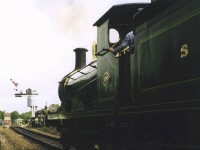
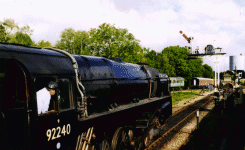
In the picture on the left, SECR C Class, Nº 592, (the
first loco not to be hand signalled into Horsted Keynes station
since 4th January), approaches with the 11.00am ex-Sheffield
Park. On the right is the following day's first train, this time
hauled by BR Class 9F, 92240.
The Permanent Way work that was due to commence on 4 October
after the cessation of daily running had to be put back until
November due to the filming on the line of "The Railway
Children". Fortunately the fine weather that we enjoyed in
October lasted into November as well so the work wasn't held up.
During the first week the P Way gang had possession of the line
the point (23B) by the south ground frame was lifted, the ballast
dug out and new drainage put in prior to re-positioning of the
point. The second week saw their attention turn to the next
point, 22B. This point has been the source of problems for many
years, largely due to a flood at the south end of the station
which left a lot of mud in the ballast. Despite regular packing
(a bit like putting out a fire with thimbles of water) the point
has continued to settle which caused, amongst other things, the
signamen considerable difficulty at times when changing the point
as the rails were bearing down on the point rodding. When the
timbers of the old point were lifted it could be seen that they
were sitting on a bed of 100% Sussex Clay with not one piece of
ballast in sight! The clay was dug out to a depth of some 18
inches, new ballast laid and a new point installed. The track
towards the platforms was also lifted, ready for re-ballasting
and re-laying, in the case of Nº2 road on a slightly
different alignment. The third and final week saw the beginning
of the Ardingly point being installed, pointing the way west for
the future! This point will, eventually, form one half of a
crossover with the other half leading to the new platform
Nº1. The tracks into Nº2 and Nº3 platforms were
replaced ready for the resumption of the normal timetable on 27
November. Point machines have been installed on all the running
points south of the station although the south groundframe will
continue to operate the point (23B) there for several more
months.
First Quarter 2000
One result of the new point being installed immediately south of
platform Nº2 was that, as it was a few yards further north
than the old one, the signal (old Nº9) controlling the exit
from the platform road was a few feet beyond the start of the
point which was not a good situation! 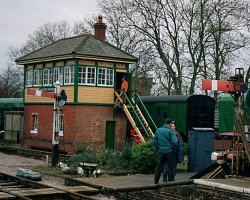 Sunday 2 January saw the S & T gang
installing a temporary replacement signal at the end of the
platform and removing the original. Eventually a brand new
three-arm bracket signal is planned for this location,
controlling exit from Nº1 platform to the Ardingly line and
exits from Nº2 platform to both the Ardingly and Sheffield
Park lines.
Sunday 2 January saw the S & T gang
installing a temporary replacement signal at the end of the
platform and removing the original. Eventually a brand new
three-arm bracket signal is planned for this location,
controlling exit from Nº1 platform to the Ardingly line and
exits from Nº2 platform to both the Ardingly and Sheffield
Park lines.
Right: Two ways to stop! The temporary situation that
existed for a couple of hours whilst the new signal (right of
picture) was being installed. The toe of the point (and the point
machine) can be seen to be just inside the old signal.
Photo © Chris Majer
The temporary signal is a SR metal arm on a lattice LBSCR post
which replaced a wooden LBSCR arm on a tapered wooden LBSCR post.
This post was quite rotten below ground level so will be reduced
in height by about 4 feet and used to support the shunting bell
when it is re-instated in Horsted Keynes down yard.
For the last two weeks of March and the first week of April
the P Way Gang and the S & T moved in and took possession of
the station midweek. During this time they installed the new
crossover between Nº2 and Nº3 roads just to the north
of the station. The northern point of this crossover is, in fact,
a tandem point also providing access to and from Nº1
road.
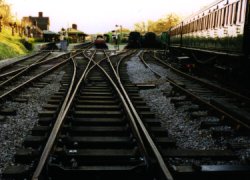
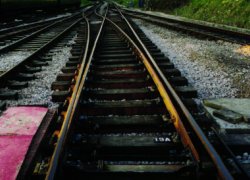
Left. The tandem point looking south down
Nº 2 road. Right. The new crossover looking north up Nº
3 road.
The point to the north of this, leading to the up yard, had
some of its rails replaced as they had originally been part of a
left hand point and had been re-aligned to be used in the right
hand point that used to lead into the Dock siding (before the
point was moved to the up yard). These rails have now been
positioned to the south of the station where they will form part
of the (left hand) point leading from the Ardingly line into
Nº1 and Nº2 roads.
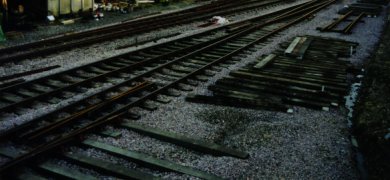
Left. The rails from north of the station can be seen on
the right of the picture, above the stock of sleepers. In the
left foreground are the beginnings of the point from Nº2
road to the Ardingly line. The rails sitting in the four foot
just above it will form part of the point from the Ardingly
line
This point is being built by Graham Ward's third Sunday of the
month P Way gang.
The work-in-hand is a massive task overall, with no firm date yet
for the likely re-commissioning of the signalbox's lever frame.
Another problem we now face is that we are reversing the work
of the LBSCR and are rebuilding the
canopy on number one platform, thus reducing the view of the
station area from the signalbox. To combat this the whole station
area will have track circuits installed so that both the
signalman and the locking system will always know when and where
a track is occupied.
Second Quarter 2000
After the flurry of activity during March things quietened
down a bit and attention was turned to some much-needed attention
to the track to the north of the station. By the beginning of
June, however, the point at the south of Nº2 road was built
(previously it was just a trap point protecting the line south)
and the frog for the point from the Ardingly line was in place.
Inside the Signalbox there are several signs of how the work is
proceeding with most of the levers back in situ, although still
in primer. Dave Phillips of the S & T has done a magnificent
job of removing all the previous layers of paint and reducing the
levers to bare metal, re-furbishing all their fittings,
re-assembling and priming all forty of them. No small task!
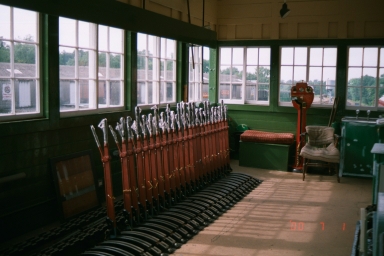
Right: The levers start to return to the box! For the
present they are in primer until the time comes to paint them
their final colours - Red for Home Signals, Yellow for Caution
(Distant) Signals, Black for Points, Blue for Locks and Brown for
Releases.
Third Quarter 2000
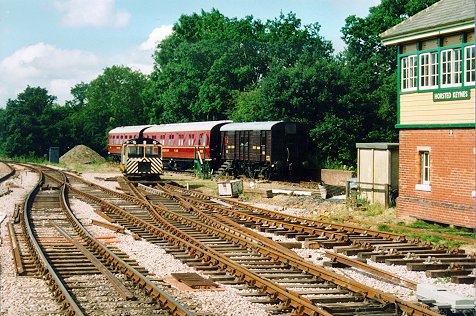
July has seen a lot accomplished. First the point that will
take Ardingly traffic into either Nº1 or Nº2 roads was
completed and then, on 28th July, just in time for the Steam
Fair, the buffers at the south end of Nº1 road were removed
and this line was connected to the track from the Ardingly
direction (at present just a short spur). So, for the first time
in at least 65 years it is possible to enter the platform from,
and leave towards, the south! New drains are being installed
alongside the new Ardingly line which hopefully will help to keep
the track in good condition for many years to come. The "old"
Ardingly spur, used for storing rolling stock that is awaiting
its turn for restoration, has been cut and the line slewed over.
The Ardingly end will mate up with the new line from the station
and the Horsted end has moved a little to the east so that it can
be used as a siding still. This will, hopefully, mean we can keep
the "new" line free of stored rolling stock so that it can be
used, for example, by Clive Groome's
Footplate Days and Ways. This means his footplate
experience customers would have a good run from north of the
station to some way south of it without the need to come out into
the main platform area.
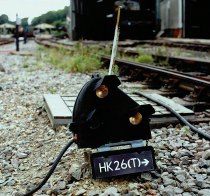
By the 12th August several more changes came into use. The
south groundframe was de-commissioned on Wednesday, 9th August on
which date the point that had been controlled by the groundframe
(23B) and the Nº3 road down platform starter became
controlled directly from the Signalbox along with the other half
of the crossover, point 23A and the next day the disconnected
shunt signal controlling the exit from the down yard was replaced
by a temporary position light signal, also worked directly from
the 'box. See Barry Coward's photo, Right. So, in a
couple of days Horsted signalling took a leap from the 19th
Century to the 21st Century with power operated points, some
track circuits and colour light signalling!
The following day the connection was made between the south
end of Nº1 road and the old Ardingly siding making Horsted
look a proper junction once more - and with the illusion of
double track towards Ardingly. It was all rather a surprise to
the weekend station staff when they arrived on Saturday,
especially when the points south of Nº4 road kept changing.
Each time the points were set for the down yard they expected a
trolley to appear!
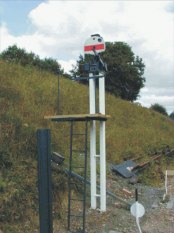
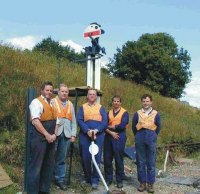
To the north of the station a new signal post has sprouted
- see photos from Martin Oakley: Left: the new signal,
Right: with the Alf Brown Gang. This is an elevated
shunt signal, some nine feet above the ground. It will make
sighting of the signal easier as the siding at that point curves
round a rising bank and was inspired by a similar signal that
used to exist at Tunbridge Wells. This signal, once again, is the
work of the Alf Brown Gang's "Signals from Scrap Rails
Company".
Fourth Quarter 2000
After the visible work of the summer and autumn not too much
was apparent in the closing months of the year although much was
done "behind the scenes". Work continued with the installation of
wiring for the track circuits & etc. whilst inside the
Signalbox the Block Shelf for the instruments was returned to its
rightful place. Then the bracket signal at the south end of
Nº4 road was removed and, temporarily, replaced with a stop
signal and a SR Disc shunt signal, both non-working. The week
before Christmas saw Nº22 points (from Nº2 road south
to Nº3 road) powered up so that they can be controlled
directly from the Signalbox. With the prospect of wet 'n' windy
weather that is a most popular move as far as all the Signalmen
are concerned, especially now the embankment slip south of
Kingscote means more use of all the roads at Horsted Keynes!
Click to return to the top of the page.
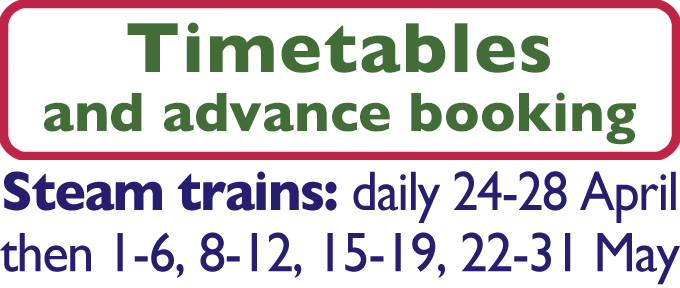


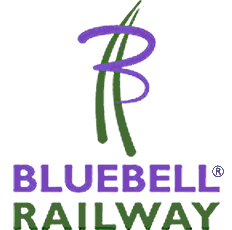




 The keen observer
will see that there has been some work done to the north end of
the ground floor of the signalbox. The brickwork needed some
remedial work and, at the same time, the doorway has been moved
about 18 inches towards the rear of the box. This is because the
bottom of the levers in the re-installed frame when "normal" in
the frame would, by the doorway, be a dangerous hazard for anyone
venturing inside. The work has been excellently carried out by an
outside contractor and, once a little weathered, will show no
sign of the alteration having been made. The lintel over the
door, the stone step (moved exactly as it was, crack and all!)
and most of the original bricks were re-used. The cost of this
work, some £870 for labour (the materials were supplied by
the railway) was met from the proceeds of the Football
Competitions run to raise funds for the work now taking place on
the signalbox and signalling.
The keen observer
will see that there has been some work done to the north end of
the ground floor of the signalbox. The brickwork needed some
remedial work and, at the same time, the doorway has been moved
about 18 inches towards the rear of the box. This is because the
bottom of the levers in the re-installed frame when "normal" in
the frame would, by the doorway, be a dangerous hazard for anyone
venturing inside. The work has been excellently carried out by an
outside contractor and, once a little weathered, will show no
sign of the alteration having been made. The lintel over the
door, the stone step (moved exactly as it was, crack and all!)
and most of the original bricks were re-used. The cost of this
work, some £870 for labour (the materials were supplied by
the railway) was met from the proceeds of the Football
Competitions run to raise funds for the work now taking place on
the signalbox and signalling.

 Sunday 2 January saw the S & T gang
installing a temporary replacement signal at the end of the
platform and removing the original. Eventually a brand new
three-arm bracket signal is planned for this location,
controlling exit from Nº1 platform to the Ardingly line and
exits from Nº2 platform to both the Ardingly and Sheffield
Park lines.
Sunday 2 January saw the S & T gang
installing a temporary replacement signal at the end of the
platform and removing the original. Eventually a brand new
three-arm bracket signal is planned for this location,
controlling exit from Nº1 platform to the Ardingly line and
exits from Nº2 platform to both the Ardingly and Sheffield
Park lines.








